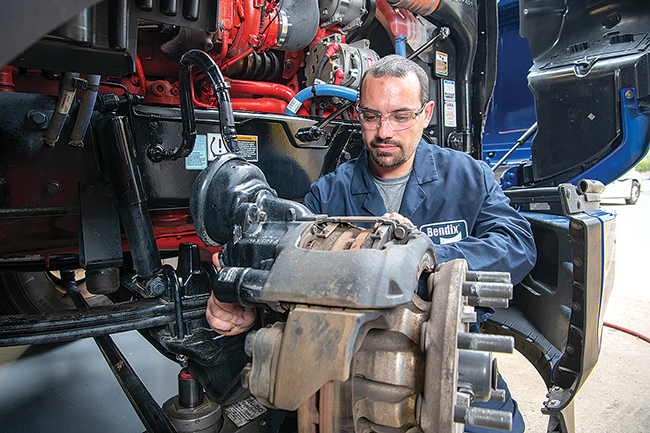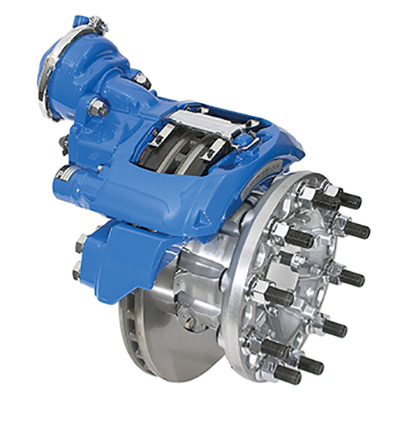
By Mark Holley
![]() Over the past decade, the escalating adoption and standard positioning of air disc brakes has marked a significant shift across the North American commercial vehicle industry, including in the transit bus and motorcoach markets. Currently, about 15 percent of buses spec air disc brakes, with that number growing steadily every year. Safety, uptime, and return on investment are all areas in which air disc brakes (ADBs) deliver advantages over drum brakes – and as advanced driver assistance systems such as full stability and collision mitigation are more commonplace, there’s a growing understanding
Over the past decade, the escalating adoption and standard positioning of air disc brakes has marked a significant shift across the North American commercial vehicle industry, including in the transit bus and motorcoach markets. Currently, about 15 percent of buses spec air disc brakes, with that number growing steadily every year. Safety, uptime, and return on investment are all areas in which air disc brakes (ADBs) deliver advantages over drum brakes – and as advanced driver assistance systems such as full stability and collision mitigation are more commonplace, there’s a growing understanding
that it makes sense to support them
with ADBs.
So, what is driving the adoption?
Delivering Safety
As a drum brake heats up during use, it’s prone to brake fade – a reduction in performance due to the expansion of the drum away from the brake shoe friction. Brake fade can start to set in during long or steep descents, or heavy stop-and-go situations, and it can lengthen a vehicle’s stopping distance.
The design of air disc brakes virtually eliminates fade since the brake rotor expands toward the friction as it heats up. Air disc brakes also cool down more efficiently.
As a result, air disc brakes provide the increased safety of 50-foot shorter stopping distances (this data is for tractor trailers) and more consistent performance compared to drum brakes, along with smoother and more stable stops, no matter the vehicle type.
 Uptime Advantages
Uptime Advantages
By their design, air disc brake pads help eliminate the possibility of rust jacking, a situation that occurs in drum brake friction when corrosion takes hold between the brake shoe and the friction material. As rust builds up on the steel beneath the brake lining, it exerts upward pressure on the friction material, eventually causing cracks and breakage.
In the maintenance bay, once a wheel is removed, changing an air disc brake pad takes about one-quarter the time it takes to replace drum brake shoes. And, since air disc brakes include an internal self-adjustment mechanism, no slack adjusters are needed, so you’ll eliminate the maintenance time required for brake adjustments that are necessary when new brake shoes or drums are installed.
In 2019, Bendix introduced pad wear sensing availability for air disc brakes, which can help remove the guesswork from ADB pad replacement. Sensors in the pad determine when a pad is nearing its replacement period. Next, either the ECU (electronic control unit) or the Bendix® Trailer ABS (TABS) unit on the trailer will detect the worn sensor and record and broadcast a Diagnostic Trouble Code (DTC). If the unit is equipped with telematics, then the fleet can be notified that pad replacement is needed. At the time of notification, sufficient pad life remains to enable the fleet to schedule replacement service before it’s an emergency situation.
Pad wear sensing technology enables fleets to proactively schedule maintenance. This proactiveness protects costly components such as rotors from being damaged by worn-out friction, gives fleets the advantage of optimizing their friction replacement schedules, and reduces the need for technicians to measure friction thickness.
Making the Right Decisions
From full-stability technologies to today’s leading-edge enhanced collision mitigation capabilities, advanced driver assistance systems (ADAS) are growing in popularity. As these systems evolve, they continue to require reliable, consistent stopping power at the wheel-ends to perform at their best. Fleets understand that it makes sense to support their ADAS systems with air disc brakes because they provide shorter stopping distances than drum brakes, virtually eliminate brake fade, and perform consistently in demanding situations.
ADB’s critical role in the performance of safety systems places added importance on proper maintenance, particularly when it comes to replacing ADB pads.
The aftermarket provides many friction options, not all of which will meet FMVSS-121 stopping distance requirements in effect at the time of a vehicle’s manufacture. When changing out your vehicle’s friction, Bendix recommends replacing with like-for-like components in order to maintain OE braking performance levels – helping keep roads safer and reducing your risk of liability.
As ADBs have gained market acceptance, pad friction has evolved to account for varying factors, including application and duty cycle. Bendix created new frictions to meet the wear rate performance needs based on these factors. One of those frictions (Bendix® BX283TM) helps manage high temperatures in applications with repeated, frequent brake usage, such as buses. Air disc brake pads are also required to comply with the Environmental Protection Agency’s Copper-Free Brake Initiative (Phase 2 took effect on January 1, 2021), and Bendix already offers friction that will remain compliant through 2024.
Mark Holley is director of marketing and customer solutions – Wheel-End, Bendix Commercial Vehicle Systems LLC. Holley has over 25 years of experience leading teams to provide innovative products and solutions to the commercial vehicle industry.
